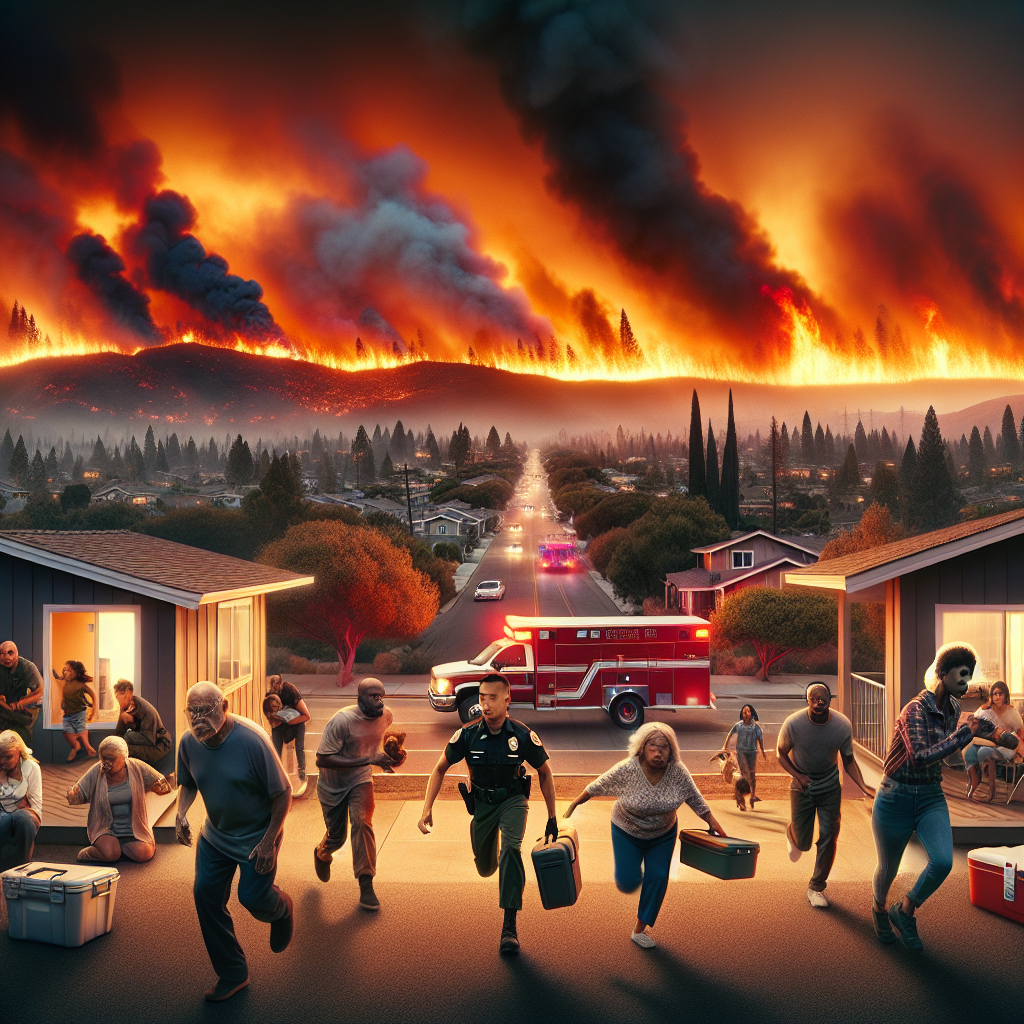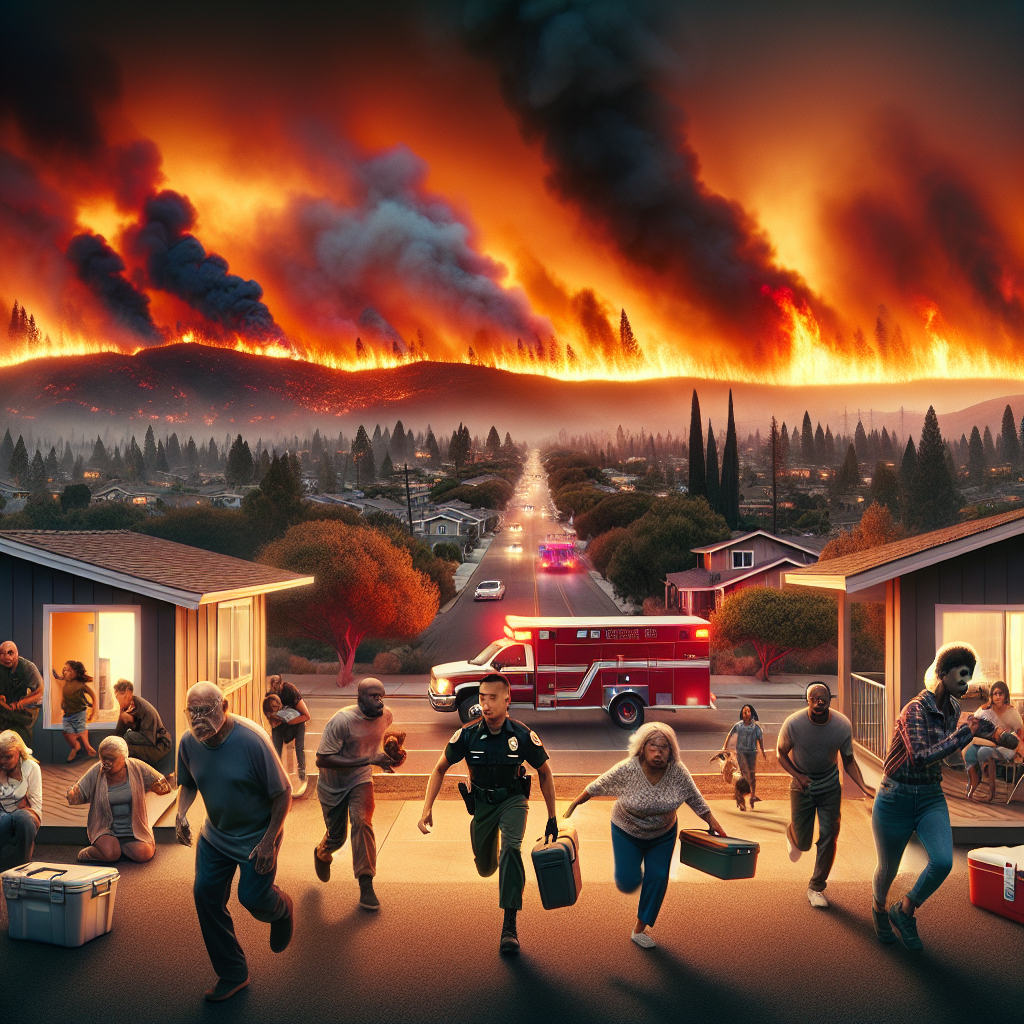Imagine living in an area prone to devastating wildfires, with the constant threat of danger lurking just beyond your doorstep. Your safety and the safety of your loved ones become your top priority. That’s why having a well-prepared and efficient wildfire evacuation plan is essential. This article will guide you through the necessary steps to ensure a smooth and timely evacuation, giving you peace of mind during uncertain times.

Understanding Wildfires
What are wildfires?
Wildfires, also known as forest fires or bushfires, are uncontrolled and rapidly spreading fires that occur in natural areas such as forests, grasslands, or other vegetation. These fires can vary in size and intensity, posing significant risks to both human life and the environment. Wildfires often spread through the ignition of dry and flammable vegetation, which can be caused by various factors.
Causes of wildfires
There are several causes of wildfires, both natural and human-induced. Natural causes include lightning strikes, volcanic eruptions, and spontaneous combustion due to high temperatures and dry conditions. However, human activities are frequently responsible for igniting wildfires. These activities can range from unintentional acts such as discarded cigarettes or unattended campfires to intentional acts of arson. Additionally, power line failures, equipment malfunctions, and controlled burns that get out of control can also lead to devastating wildfires.
Impact of wildfires
The impact of wildfires can be severe and wide-ranging. They pose immediate threats to human life, property, and infrastructure, while also causing significant damage to wildlife habitats and ecosystems. The smoke and toxic gases produced by wildfires can result in poor air quality, leading to respiratory problems for those exposed. Furthermore, wildfires can result in the loss of homes, schools, and businesses, displacing families and disrupting communities. The destruction of vegetation can also lead to soil erosion and increased risk of flooding in affected areas.
Importance of Having an Evacuation Plan
Minimizing casualties
Having an evacuation plan is crucial in minimizing casualties during a wildfire. By being prepared and knowing what steps to take, it increases the chances of a safe and efficient evacuation. A well-prepared plan ensures that you and your loved ones can quickly and safely evacuate the area before the fire reaches your location, minimizing the risks of injury or fatalities.
Protecting property and infrastructure
Another important reason for having an evacuation plan is to protect property and infrastructure. By having a plan in place, you can take proactive measures to safeguard your belongings from fire damage. Properly securing your home and taking necessary precautions can significantly reduce the risk of your property being destroyed by wildfires.
Ensuring timely and organized evacuation
An evacuation plan helps ensure timely and organized evacuations, especially in situations where time is of the essence. It allows you to gather essential items, notify your loved ones and neighbors, and evacuate in an orderly manner. With a well-thought-out plan, you can avoid panic and confusion, making the evacuation process smoother and more efficient.
Preparation Steps
Assessing wildfire risk
The first step in preparing for wildfires is to assess the risk in your area. Research and identify the likelihood and frequency of wildfires occurring in your region. Understand the terrain, weather patterns, and historical wildfire data. This information will help you gauge the potential risk and prepare accordingly.
Creating a household emergency plan
Developing a household emergency plan is crucial in preparing for a wildfire. Sit down with your family members and discuss the necessary steps to be taken in the event of an evacuation. Assign roles and responsibilities to each family member, including designated meeting points and communication methods. Ensure that everyone understands the plan and knows what to do in case of an emergency.
Identifying evacuation routes
Identify multiple evacuation routes and familiarize yourself with them. This is essential as certain routes may become inaccessible due to fire or road closures. Look for alternative routes and ensure that you are aware of any potential obstacles along the way. Familiarizing yourself with these routes will help you navigate quickly and efficiently during an evacuation.
Gathering emergency supplies
Prepare an emergency supply kit that includes essential items such as non-perishable food, water, medications, a first aid kit, flashlights, batteries, and a battery-powered radio. These supplies will sustain you and your family during an evacuation or in case of prolonged periods without access to basic necessities.
Keeping important documents and belongings ready
Gather and keep important documents such as identification, insurance policies, and medical records in a safe and easily accessible place. It is also advisable to create digital copies of these documents and store them in a secure, cloud-based storage service. Additionally, gather sentimental items and irreplaceable belongings that you would like to take with you during an evacuation. Keep them in a designated location for easy and quick retrieval.
Developing a communication plan
Establish a communication plan with your family and friends so you can stay connected during an emergency. Ensure that everyone has a list of emergency contacts and agrees on a method of communication, such as text messaging or a designated family member acting as a central point of contact. This will help you stay informed, coordinate plans, and receive important updates during a wildfire evacuation.
Early Warning Systems
Advantages of early warning systems
Early warning systems play a critical role in alerting communities about the threat of an approaching wildfire. These systems provide valuable time for people to evacuate and take necessary precautions. By receiving warnings in advance, individuals have the opportunity to prepare themselves, their families, and their properties, reducing the potential dangers associated with wildfires.
Types of early warning systems
There are various types of early warning systems used to detect and inform people about wildfires. One commonly used system is remote sensing technology, such as satellites and aerial surveillance, which can detect heat signatures and smoke patterns associated with wildfires. Additionally, community-based systems, including sirens, emergency broadcasts, and smartphone apps, can provide real-time updates and alerts to individuals in affected areas.
Utilizing weather alerts and news updates
Monitoring weather alerts and news updates is an essential part of wildfire preparation. Stay informed about changing weather conditions, as high temperatures, dryness, and strong winds can increase the risk of wildfires. Sign up for local emergency notifications, follow reputable news sources, and take heed of any evacuation orders or alerts issued by authorities.
Installing smoke and fire detectors
Install smoke detectors and fire alarms in your home to provide early warning in case of a fire. These detectors can sense the presence of smoke or fire, triggering an alarm to alert you and your family. Regularly check and maintain these devices to ensure they are functioning properly and replace batteries as needed. Having reliable smoke and fire detectors can provide an additional layer of safety during a wildfire evacuation.

Evacuation Alert and Order
Understanding evacuation alerts
Evacuation alerts are issued when there is a potential threat of a wildfire reaching your area. These alerts serve as a warning to residents that evacuation may become necessary in the near future. It is crucial to take these alerts seriously and begin preparing for a potential evacuation, even if an evacuation order has not yet been issued.
Responding to an evacuation alert
When you receive an evacuation alert, it is important to act promptly and start implementing your evacuation plan. Begin by gathering your emergency supplies, important documents, and any essential belongings. Stay informed about the situation through official channels and communicate with your family members and neighbors about the alert. Keep a close eye on updates and be prepared to evacuate at short notice if an evacuation order is subsequently issued.
Evacuation order: When and how it is issued
An evacuation order is issued when there is an imminent threat to life and property posed by a wildfire. This order is a mandatory instruction from authorities to leave the area immediately and seek shelter in a safer location. It is crucial to follow the instructions from emergency services and local authorities during an evacuation order. Failure to evacuate can jeopardize your safety and the safety of emergency responders.
Follow official instructions
During an evacuation alert or order, it is important to follow the instructions and guidance provided by official sources such as emergency services, local authorities, and law enforcement. They are trained to assess the risks and make decisions that prioritize public safety. Stay informed through official channels, listen to emergency broadcasts, and comply with evacuation instructions to ensure your safety and the safety of others.
Preparing the Home
Clearing flammable debris
Before a wildfire approaches, it is important to clear flammable debris from around your home. Remove dry leaves, branches, twigs, and other flammable materials that could ignite and contribute to the spread of the fire. Clean gutters and secure loose debris to minimize the risk of embers igniting your property.
Securing openings
Take measures to secure openings in your home to prevent the entry of sparks and embers. Seal gaps around windows and doors, install metal mesh screens on vents, and use fire-resistant materials for roofing and siding. These steps can help reduce the vulnerability of your home to fire and increase its chances of withstanding a wildfire.
Creating defensible space
Creating defensible space around your property is an effective way to protect your home from wildfires. Clear vegetation and create a buffer zone by removing flammable plants, thinning vegetation, and maintaining a safe distance between trees and structures. This space acts as a barrier, slowing down or stopping the spread of a wildfire towards your home.
Protecting against ember attacks
Embers are a major cause of home ignitions during wildfires. Take measures to protect your home from ember attacks by installing ember-resistant vents, covering chimneys with spark arrestors, screening openings for debris prevention, and using fire-resistant materials for exterior features. Regularly inspect and maintain these protective measures to ensure their effectiveness.
Preparing pets for evacuation
Pets are an important part of our families, and their safety should be included in your evacuation plan. Make sure your pets are properly identified with collars, tags, or microchips. Keep a pet emergency supply kit ready, including food, water, medication, leashes, and carriers. Identify pet-friendly evacuation shelters or boarding facilities in advance, as some shelters may not allow pets, and make arrangements accordingly.

Evacuation Checklists
Emergency supply kit checklist
- Non-perishable food
- Bottled water
- Medications and first aid kit
- Flashlights and extra batteries
- Battery-powered radio
- Personal hygiene items
- Essential documents (identification, insurance policies, etc.)
- Phone chargers and backup battery packs
Important documents checklist
- Identification documents
- Insurance policies
- Medical records
- Property deeds or leases
- Birth certificates and passports
- Social security cards and driver’s licenses
Valuables and sentimental items checklist
- Jewelry
- Family heirlooms
- Photo albums
- Sentimental items
- Personal keepsakes
Pet evacuation checklist
- Pet food and water
- Medications and medical records
- Leashes, collars, and harnesses
- Carriers or crates
- ID tags and microchip information
- Toys and blankets
Evacuation Process
Staying calm and following instructions
During the evacuation process, it is important to stay calm and composed. Follow the instructions given by emergency services and authorities, as they are trained to handle these situations. Maintain a clear mind and focus on implementing your evacuation plan while following evacuation routes and traffic instructions.
Notifying neighbors or loved ones
If time permits, notify your neighbors or loved ones about your evacuation plans. Inform them of your intended destination and keep a list of emergency contacts for easy communication. By letting others know about your plans, they can be aware of your whereabouts and well-being.
Preparing vehicles
Ensure that your vehicles are prepared for evacuation. Keep them fueled and in good working condition. Load your emergency supplies and evacuation kits into your vehicles ahead of time, ensuring that everything is easily accessible. Have a map or GPS navigation system handy to help you navigate the evacuation routes.
Securing the property while leaving
As you leave your home during an evacuation, take steps to secure the property as much as possible. Close all windows and doors, shut off gas valves, and turn off electrical appliances. If time allows, move flammable items away from the house and cover them with fire-resistant materials. Take necessary precautions to make your home as resilient as possible against a potential wildfire.
Choosing safe evacuation routes
During an evacuation, it is important to choose safe evacuation routes. Follow the guidance provided by emergency services and use designated evacuation routes whenever possible. Avoid shortcuts or unfamiliar routes that may pose additional risks. Stay alert, watch for road signs, and be prepared for potential traffic congestion or delays.

Emergency Shelters and Community Resources
Identifying nearby emergency shelters
Before a wildfire occurs, familiarize yourself with the locations of nearby emergency shelters. These shelters provide temporary accommodation and support to evacuees during an emergency. Contact local authorities or visit community websites to obtain information about the nearest shelters and their operating procedures.
Preparing for staying in a shelter
If you need to stay in an emergency shelter during a wildfire evacuation, there are a few essential items you should bring with you. These may include bedding, personal hygiene items, necessary medications, clothing, important documents, and any special items for infants or elderly family members. Check with the shelter in advance to understand their specific requirements and restrictions.
Connecting with community resources
During a wildfire evacuation, it is important to connect with community resources for support and assistance. Local organizations, such as the Red Cross, may provide services such as food, water, shelter, and emotional support. Utilize community resources to stay informed, access supplies, and receive assistance during and after the evacuation.
Seeking assistance for vulnerable individuals
If you or someone in your household has special needs or is considered vulnerable, it is important to seek assistance during a wildfire evacuation. Contact local authorities or community organizations in advance to inform them of your circumstances and discuss any necessary arrangements. They can provide guidance and support to ensure the safety and well-being of individuals with specific needs.
Post-Evacuation Steps
Waiting for official clearance
After evacuating, it is important to wait for official clearance before returning to your home or property. Do not attempt to re-enter the area until authorities have deemed it safe to do so. Follow their instructions and heed any warnings or restrictions that may still be in place.
Inspecting and assessing property damage
Once you are cleared to return, inspect and assess the extent of the damage to your property. Take photographs or videos of any damage for insurance purposes. Be cautious of any hazards or structural issues that may have occurred during the wildfire. If necessary, seek professional assistance to assess the safety and stability of your home.
Recovering and contacting insurance providers
Contact your insurance provider as soon as possible to report any damage caused by the wildfire. Provide them with information and documentation regarding the extent of the damage. Follow their guidance on the steps to take for insurance claims and the necessary documentation they may require for the process.
Addressing emotional well-being
Experiencing a wildfire and evacuating can be a traumatic experience. It is important to address your emotional well-being and that of your family members. Reach out to support services or community resources that can provide counseling or assistance with coping strategies. Take time to process the experience and prioritize self-care during the post-evacuation period.
In conclusion, understanding wildfires, having an evacuation plan, and taking proactive steps to prepare for a potential evacuation are crucial in minimizing the risks of casualties, protecting property, and ensuring safe and organized evacuations. By assessing wildfire risks, creating emergency plans, utilizing early warning systems, following evacuation alerts and orders, preparing the home, and having checklists ready, individuals can better navigate the evacuation process while prioritizing safety. Additionally, connecting with emergency shelters, community resources, and addressing post-evacuation steps are essential for recovery and addressing emotional well-being. Remember, being prepared and informed is key to effectively responding to the threat of wildfires and ensuring the safety of yourself, your loved ones, and your community.






